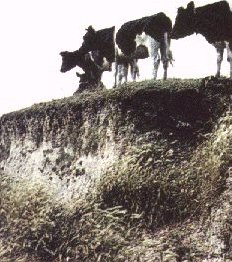
Last change:
30-3-2000;
reactions?
e-mail me
the history of Wieringen
Seaweed
 | Before the Zuiderzee was closed off in 1932, around the island of Wieringen large fields of seaweed could be found. It has even been suggested that the name "Wieringen" is derived from the Dutch word for seaweed, Wier. Linguistic experts do not agree on this, but that's a whole different story. For the Wieringer people of those days, the seaweed formed a nice additional income. When dried, seaweed was used as stuffing in seats and matrasses all over the world. Only when new synthetic materials became available in this century the use of seaweed for stuffing diminished. In even earlier days, dried seaweed was used on the island for constructional purposes. The most striking example is without any doubt the southside dike, which was entirely made out of dried and piled up walls of seaweed. A considerable part of this medieval dike still exists and is now a unique protected monument. |
 Every now and then, the Wieringer fishermen went out to the seaweedfields for harvesting. They sailed their
little boats to the edge of the field and anchored. Two men put on special pants with waders and stepped overboard.
Carrying normal scythes ("zeisen") or with specially prepared ones with longer blades, they walked into the field.
With water up to their armpits they started mowing. This was very heavy work, since the mowing had to be done under
water. Dangerous too, because you didn't see what you were doing.
Every now and then, the Wieringer fishermen went out to the seaweedfields for harvesting. They sailed their
little boats to the edge of the field and anchored. Two men put on special pants with waders and stepped overboard.
Carrying normal scythes ("zeisen") or with specially prepared ones with longer blades, they walked into the field.
With water up to their armpits they started mowing. This was very heavy work, since the mowing had to be done under
water. Dangerous too, because you didn't see what you were doing.The loose seaweed floated towards the surface and if the currents had not already taken it to the boats, other fishermen dragged it there. With pitchforks the weed was hoisted aboard (see first picture).
The processing of the seaweed


This wasn't the end of the story, because a long process on land followed before bales of dried seaweed could be sold. First it had to be washed out. The salt in the seaweed (the Zuiderzee was not yet closed off, so it was salty) had to be rinsed out. If this was not done properly, the dried weed would attract water, which was absolutely forbidden.
 When free of salt,
the weed was dried, pressed into bales (like hay, see last picture) and stored in the socalled seaweed warehouses.
There must have been dozens of them in Den Oever and De Haukes / Westerland, but if you want to see one nowadays, you'll have to go to the Zuiderzeemuseum in Enkhuizen.
When free of salt,
the weed was dried, pressed into bales (like hay, see last picture) and stored in the socalled seaweed warehouses.
There must have been dozens of them in Den Oever and De Haukes / Westerland, but if you want to see one nowadays, you'll have to go to the Zuiderzeemuseum in Enkhuizen.After the Afsluitdijk was finished and the Zuiderzee turned into the IJsselmeer, the seaweedfields around Wieringen all disappeared, due to a mysterious disease. It is very likely that changing currents had something to do with it too. Whatever the reason was, this ended a truely special and unique trade.